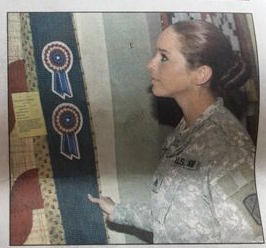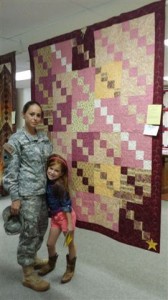Jul
22
This is my Quilt of Valor
Filed Under Healing, Life, Quilts of Valor, Tears of a Warrior, Today's War, War, Women in Combat | Comments Off on This is my Quilt of Valor
Guest Post by Carrie Hagen
SGT-TN Army National Guard
This is my Quilt of Valor.
There are many like it, but this one is mine. My Quilt is my gift. It represents my service life. I will appreciate it, as it was made in appreciation of me. My Quilt, without being made with love and support, would be meaningless. Without love and support, my service is meaningless. I must keep my Quilt always. I must respect those who show respect to me. I must remember my time of service along with those who remembered me. I will… My Quilt and I know that what counts in serving our country is not the places we’ve gone, the things we’ve done, or the battles we’ve fought.
We know standing for those in need makes it count. For them, we will stand… My Quilt of Valor is proud, as am I, because it reflects kindness found in American life. Thus, I will love it as a brother. I will love its wearing, its tearing, its patterns, its threads, its comfort, its true meaning, and its creators.
I will keep my Quilt dear and close, even as I am held dear and close. We will become part of each other. We will… Before God, I thank my supporters. My Quilt and the military are symbols of the services dedicated to our country. We are the pride of the people who made us. We will hold the memories of our military service life.
So be it, until we lay to rest and there is no enemy, but peace!
Nov
6
When Humpty-Dumpty is Mom
Filed Under PTSD treatment, Today's War, Treating PTSD, Women in Combat | Comments Off on When Humpty-Dumpty is Mom
by Janet J. Seahorn

War is hell, and there is no polite way to put it.
But when modern war is fought by women as well as men, it can take an even more challenging toil on a family and community.
As Americans, we are quickly learning that our country and its military facilities are struggling to provide appropriate treatment for its female troops. There are many services for men; yet, we are not prepared to offer some of the same options for women.
This week I had two events occur from two different parts of the country. The first was a disturbing phone call from a friend, who has several family members serving in the military. All have fought in Iraq. Her son has been to both Iraq and Afghanistan on numerous tours of duty.
Her concern, however, was for her female family member. After serving in Iraq the military woman has been home for almost three years, taking care of two small children while working full time in a demanding job. The young mother had been exposed to a great deal while deployed, and has done her best to return to normal life stateside.
Most of the time things are fine, but a few weeks ago, the memories, anxieties, and panic attacks returned with a vengeance. As we have discussed numerous times in our blogs, the ghosts of combat often come back to take up residence in the homes of the military personnel.
Without hesitation, this bright lady and her family sought help through the VA. She has wisely enrolled in our local VA Clinic upon return from combat. This time, however, she would need more intense treatment.
Not a problem, except, that the only facility that could accommodate women only is in another state, making the decision to leave her family and work a great deal more difficult.
The second incident came via an article in the New York Times which was sent to me exactly two days after the first event. Reading over the article’s information was all too familiar. I had heard it just two days before. The article by Damien Cave stated, “Never before has this country seen so many women paralyzed by the psychological scars of combat.
As of June 2008, 19,084 female veterans of Iraq or Afghanistan had received diagnoses of mental disorders from the Department of Veteran Affairs, including 8,454 women with a diagnosis of post-traumatic stress — and this number does not include troops still active, or those who have never used the V.A. system” (Internet, Nov. 1, 2009).
The article continued to comment on what we have heard from many female vets, that because they are women, “people underestimate what these women have been through” (Resick, Internet, Nov. 1, 2009).
Since war has been traditionally fought by men, we have seen the Humpty-Dumpty effect. But what happens when Humpty is Mom? What happens when Mom is the wounded warrior? What happens to the children? What happens to the organizational system of the home: the washing, cooking, cleaning, and daily tasks?
Who steps up to help nurture the nurturer when she needs comfort, care, and support? These are vital questions that need to be explored and addressed.
When Humpty-Dumpty is Mom, she can be put back together; however, the tools and glue may be pink instead of blue.



